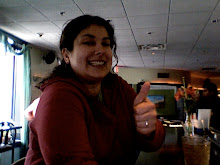Oh yes indeedy! Lately I've been weighing the relative merits of going in blind to this type of undertaking versus knowing what to expect. I think the distinction is really that between fear and dread. I'm not particularly scared this time around, but I am really really really not looking forward to going through it all again. Poop. But! Meanwhile my post-op hip is treating me fantastically, which is a good motivator for RPAO as well. Until recently my right hip has remained relatively asymptomatic, save for some incessant popping that only started after my LPAO. The past few days, though, have slayed me with sciatic pain on the right side, something I also experienced early on after diagnosis when I was just sorting out all the weird ways my left side had been coping. (Even then it was only on the right side, which I guess is fairly common for sciatica.)
I saw Dr. Hoo yesterday in so much pain I wasn't sure I could get up off the table, but of course she picked up immediately on the source of the discomfort and went to work. When I finally did get up the pain was somehow even worse and I could barely get back into my car. An evening's relaxing with three Lidoderm patches and a good night's sleep seem to have allowed the NSA voodoo to work its magic, though, as I woke up this morning with nothing but a dull ache remaining. Great success! Also a fine reminder of what it's going to be like when I can't bend on the right side - nearly busted out my hip kit grabber, but I think I'll save that for when I'm back on crutches for real. :)
Subscribe to:
Post Comments (Atom)

1 comment:
I’ve found sciatic pain is often the result of a rotated pelvis. This happens when the muscles in front of the pelvis asymmetrically pull one side of the pelvis forward. This creates unilateral spinal extension and can pinch the nerve roots composing the sciatic nerve. This is correctable with exercise but the other big problem is that movement habits are reinforcing these issues. A couple of examples of habits that may be perpetuating sciatic pain are standing or working asymmetrically putting more weight on one leg than the other. This leads to the asymmetries in the muscle tightness. Typically, sciatic pain responds relatively quickly to corrections on both fronts. I've just written a book about fixing back and sciatic pain using an approach that has been very effective over the last few years. I hope this helps.
Rick Olderman
Post a Comment